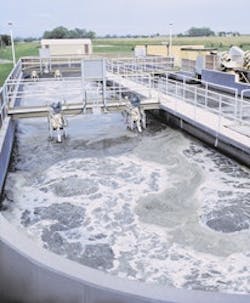Designed for Generations
Nearly 25 years ago, the consulting engineering firm Banner & Associate, Inc. designed an efficient wastewater treatment facility for the city of Madison, S.D., that featured process control, flexibility and treatment efficiency while minimizing operating and maintenance costs. Key to the system was the aspirator aeration system that supplied reliable oxygenation and mixing to the oxidation ditch.
After decades of service, the aerators will be retrofitted this spring with an advanced process aerator/mixer system that will be able to provide “more for less” to the city’s next generation. The advanced Aire-O2 Triton process aerator/mixer system, manufactured by Aeration Industries International, Inc. , has the unique ability to mix and aerate independently to facilitate biological nutrient removal. Fewer units are required to meet permit, which translates into increased energy savings.
Current average influent characteristics are 139 mg/L BOD5 and 137 mg/L TSS. Following pretreatment and primary treatment, the wastewater flows into an oxidation ditch for secondary treatment. The oval-shaped ditch is 123 ft long with a 20-ft channel width and 9-ft depth. Effluent meets or exceeds 10 mg/L BOD and is discharged by infiltration percolation.
Past: Operational Flexibility and Simplicity
Important factors in the original aeration choice were loading demand fluctuations, winter treatment efficiency, effluent discharge restrictions, maintenance considerations and of course, cost. The AIRE-O2 aspirator aeration system was chosen. Eight 20-hp bridge-mounted aerators were grouped in pairs at four locations.
"The use of eight aerators allows for a 4 to 1 turn down in oxygen transfer capability while assuring complete mixing of the ditch under all load conditions,” said Connie Silva, the foreman, who has been with the facility since 1989. "We like the [aeration system]. It’s readily accessible and maintenance is easy."
The aerators inject air below the water’s surface, providing a high velocity of dissolved oxygen and mixing to keep solids in suspension year-round, regardless of freezing winter temperatures. The units eliminate evaporative cooling and aerosols. The aerator’s custom-designed bridges provided good operator access for routine maintenance.
Future: Energy Savings and BNR Capabilities
The aerator/mixers combine fine-bubble aeration and a slow-speed mixer in a single unit. The aerator/mixer features a mixing-only mode or an air/mix mode to isolate the two functions to provide for unparalleled process control.
“The city currently operates the facility to remove BOD5 only and not to nitrify,” said Jim Housiaux of Banner & Associate, Inc. “However, we feel it is appropriate to design the new aerators to handle both BOD5 and nitrogen loads that the facility would see in 20 years in the event of process or permit change.”
